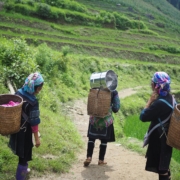Promoting Gender-Responsive Budgeting for Climate Action and Social Change
All too often, gender-responsive policy is considered separately from budgeting, and from decision making about climate change. By bringing together gender equity and budgeting policies in the context of addressing climate change, there is the opportunity to address the adverse impacts of climate change on women and gender-diverse people worldwide, and to enhance the efforts to develop more impactful climate change strategies.
Gender-responsive budgeting (GRB) is “a strategy that promotes the goal of gender equity by allocating specific budgets for gender mainstreaming.” A concept first introduced at the Nairobi World Conference on Women in 1985, “gender mainstreaming” translates into an approach to policy making across portfolios (e.g., transportation, housing, climate change, etc.) that takes into account the interests and concerns of women, men, girls, and boys. In turn, GRB can be applied to the analysis of any policy-related portfolio, including climate change.
Most explorations of GRB focus on women and men, girls, and boys, rather than on gender diversity. As reported by the Native Women’s Association of Canada’s (NWAC) Toolkit – Impact of Climate Change on Indigenous Women, Girls, Two-Spirit, Transgender and Gender-Diverse People, climate change “will negatively impact those who are already vulnerable due to inadequate access to housing, health care, food, and water among other factors,” namely, women, girls, Two-Spirit and gender-diverse People. The NWAC toolkit highlights how funding resources are crucial to facilitating environmental protection and to enabling gender-diverse members of Indigenous communities to contribute their knowledge and expertise to address climate change.
Conventionally, GRB calls for adjusting budget policies – according to revenues, expenditures, budget allocations and adjustments – to benefit all women, men, girls, and boys, and to eliminate discrimination. There are four steps to applying GRB to climate action; however, these steps can also be applied to the analysis of existing policies:
- Identify the problem using key indicators, developed through research, and analyse the problem in relation to gender impacts.
- When developing different strategies or programs (i.e., climate actions), consider how they are gender-responsive. What actions are necessary to benefit the breadth of gender-diverse people?
- When allocating the budget and reallocating funds necessary to implement programming, ensure that the budget is adequate to support gender equity.
- Engage in cyclical monitoring, checking whether expenditures are made as planned and if reallocations are needed. How have activities been executed, targets reached, and services delivered from the standpoint of the recipient(s)?
Over 100 countries have implemented GRB, and Bangladesh, Mexico, and Indonesia have implemented gender-responsive climate budgeting practices. Touted as a step toward accountability and transparency in decision making and women’s rights, GRB for climate action is also considered “an opportunity for effective collaboration between social and environmental sectors, and more effective budgeting to deliver on the 2030 Agenda for Sustainable Development and related Sustainable Development Goals (SDGs).”
Gender-responsive policy must encompass intersectionality, gender diversity, link to budgeting processes, and be developed in the context of climate change to unite efforts in promoting social change and strategies for environmental protection.
By Leela Viswanathan
(Image Credit: Annie Spratt, Unsplash)

 Annie Spratt
Annie Spratt Radoslav Bali, Unsplash
Radoslav Bali, Unsplash





 Ashkan Forouzani
Ashkan Forouzani Casey Horner, Unsplash
Casey Horner, Unsplash